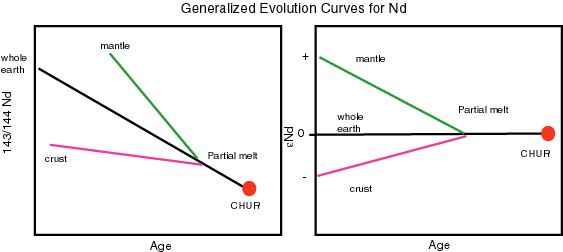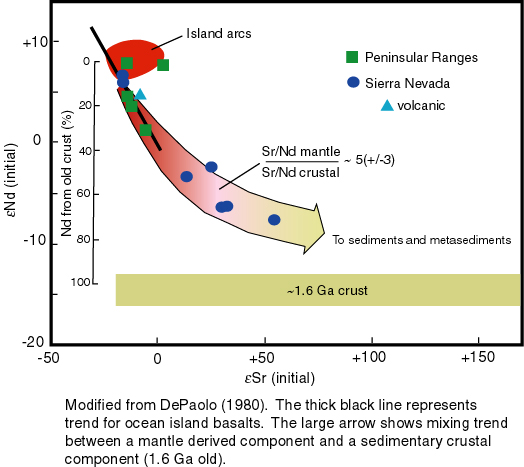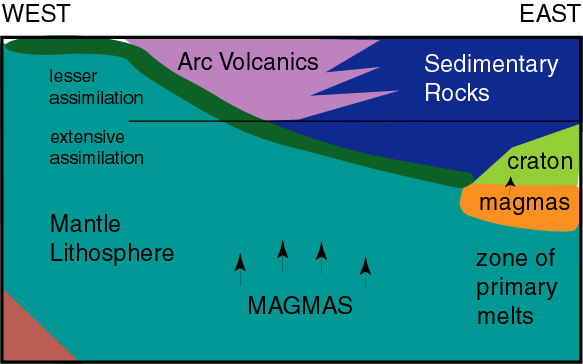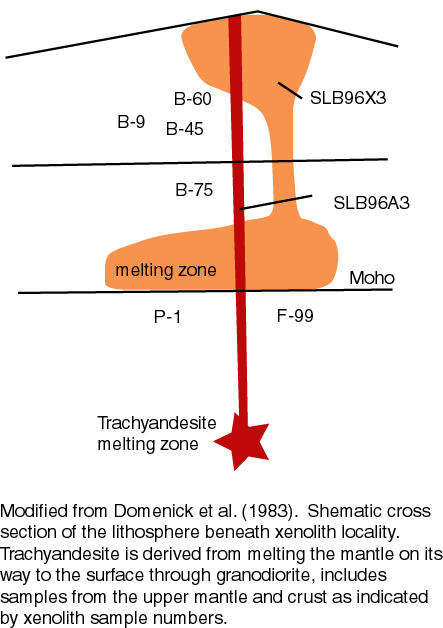
Isotope Systematics applied to the Mesozoic central Sierra Nevada batholith
VII. Using Rb-Sr and Sm-Nd get at sources for batholithic rocks
Rubidium is an alkali earth element with two isotopes: 85Rb and 87Rb. Rubidium-87 decays by beta particle emission to 87Sr (strontium). The proposed half life for 87Rb is 48.8 b.y. and the corresponding decay constant is 1.39x10-11/yr. The Rb+1 cation substitutes for K (potassium) in micas and alkali feldspars and its lithophile nature indicates that it differentiates into mantle melt phases and resides in the crust. Its daughter, the Sr+2 cation substitutes for Ca+2 , in more mafic minerals. Fractionation of these elements is based on these different oxidation states. Both elements are lithophile but Sr is more abundant in the mantle relative to it's parent Rb. Through time crustal rocks will have more radiogenic 87Sr relative to mantle rocks. The production of radiogenic Sr can be expressed with respect to a reference isotope 86Sr in the following equation:
87Sr/ 86Sr = (87Sr/86Sr)initial + (87Rb/86Sr)*(elt –1)
If you plot 87Rb/86Sr verses 87Sr/86Sr the above equation is in the form y=ax+b where the term (87Sr/86Sr)initial is the y-intercept ( which corresponds to Basalitc Achondrite Best Initial (or BABI) value for achondrite meteorites which gives an estimate of the initial Sr isotopic composition of the earth when it formed out of the solar nebula) and the slope of this line is proportional to the amount of time the rock has remained in a closed system with respect to Rb and Sr. Primary magma should inherit the isotopic signature of the mantle source providing that melting occurs under equilibrium conditions. Through time 87Sr/86Sr will be higher in older crustal rocks and lower in younger rocks. This is also true for more sialic verses more mafic rocks. This method is not so useful for dating rocks (due to open system problems) but is more helpful for determining the source of igneous rocks. Cratonal source will have a higher 87Sr/86Sr ratio than younger or more mafic source. (The above information is summarized from Dicken 1995 and Faure 1986)

In the above evolution curves for Sr, the black line represents the evolution of the whole earth with estimates of the initial value corresponding to BABI. At some time in the past there was a melting event causing the fractionation of Rb into the melt which then forms crustal material. As time goes by that Rb decays to Sr and the radiogenic Sr is enriched in the crust but depleted in the mantle. Normalizing these values to BABI we can generalize and say that positive eSr values correspond to a crustal source while negative eSr values correspond to a mantle source.
Return to the top of the page
Samarium (Sm) has 3 isotopes 147, 148, and 149 which are all radioactive but 148 and 149 have such long half lives (1016yr) that they do not produce measurable differences in daughter isotopes of 144 and 145 neodymium (Nd). The half life of 147Sm is significantly short (106 b.y.) and produces measureable differences in 143 Nd via alpha decay with 144 Nd as the reference isotope. Both Sm and Nd are rare earth elements (REE) with +3 oxidation states. They belong to the same chemical family but due to Lanthinide contraction (as atomic mass increases the elements contract because electrons in the 7F orbital do not sheild each other) Sm (z = 62) is smaller than Nd ( z = 60). Heavy rare earth elements (HREE) partition into garnet and garnet peridotites so they stay behind in the mantle. The light rare earth elements (LREE), such as Nd, can fit into some Ca+2 sites and therefore partition into the melt phase. As with the Rb-Sr system the production of Nd can be represented by the equation:
143Nd/144Nd = (143Nd/144Nd)initial + (147Sm/144Nd)*(elt –1)
If you plot 147Sm/144Nd verses 143Nd/144Nd the above equation is in the form y=ax+b where the term (143Nd/144Nd)initial represents the y intercept and the slope is proportional to the amount of time the system was closed to Sm and Nd. A bulk earth (143Nd/144Nd)initial was derived from measuring the Nd isotopic ratios from chondrite meteorites. This value corresponds the CHUR (chondritic uniform reservoir) which is the Nd isotopic composition at the time that the earth condensed from a solar nebula. Through time 143 Nd/144 Nd will be lower in older crustal rocks and higher in mantle rocks. Like the Rb-Sr system, this method is not so useful for dating rocks (due to open system problems) but is more helpful for determining the source of igneous rocks. Cratonal sources will have lower 143 Nd/144 Nd ratio than younger or more mafic sources. (The above information is summarized from Dicken 1995 and Faure 1986)

In the above evolution curves for Nd, the black line represents the evolution of the whole earth with estimates of the initial value corresponding to CHUR. At some time in the past there was a melting event causing the fractionation of Nd into the melt which then forms crustal material. The residual mantle is enriched in Sm and as time goes by that Sm decays to Nd and the radiogenic Nd is enriched in the mantle but depleted in the crust. eNd is standard notation for the Nd isotopic composition.
eNd = [143 Nd/144 Nd (sample) / 143 Nd/144 Nd (CHUR)] -1 *10^4
The diagram above shows that mantle sources have higher (more positive values of eNd) and crustal sources have lower (more negative values) of eNd.
VII. Using Rb-Sr and Sm-Nd get at sources for batholithic rocks
Fundamental problems in magma production involve the identification of magma sources, extent of contamination, depth of productions and crystallization (Ague et al. 1988). Isotopic tracers like Rb-Sr and Sm-Nd can be used to refine models of magma origins (for reasons described above) However, complications due to re-equilibration during slow cooling, the initial condition of a closed system with respect to isotopic pairs may not be correct. Domenick et al. (1983) Summarized some of the popular models for the generation of Sierra Nevada Magmas seen in the literature:
DePaolo (1980) used isotopic data to investigate the origins of plutonic rocks in the Sierra Nevada batholith. His initial observations suggested that large batholitic belts combine properties of island arcs and old continental crust
ISLAND ARCS |
CONTINENTAL CRUST |
| Linear belts of igneous rocks | Dominately plutonic |
| Formed above subduction zone | Silica rich |
| Metamorphosed volcanics have island arc compositions | Lie west of Precambrian basement |
So the question of magma generation pointed to a genetic link between continental crust and island arcs. DePaolo used Rb-Sr data from Kistler and Peterman (1973, 1978) in addition to Sm-Nd isotopic data, because Rb-Sr alone fails to link island arcs to batholiths (DePaolo, 1980).

Kistler and Peterman (1973, 1978) measured whole Sr isotopic compositions on the granitic rocks in the Sierra Nevada and contoured the values as seen in the illustration above. The results of their work showed a SE-NW trend in the data. Isotopic compositions appear to increase both east and southeast.

Granitic rocks from the Sierra Nevada batholith have eNd that vary over a large range and correlate with eSr (DePaolo, 1980). Island arcs have negative eSr and positive eNd values due to the fractionations of parent isotopes and the radiogenic ingrowth of daughter isotopes through time. Continental crust has a wide range of positive eSr but has negative eNd values. These ranges are plotted on the graph above. The arrow represents a mixing trend for the two endmembers, island arc and continental crust. Isotopic values for granitoids of the Sierra Nevada are plotted on this graph and follow a path of mixing between the continental crust and island arc. The solid black line is an approximation of bulk earth evolution in eSr v. eNd space. DePaolo (1980) concluded from this data that Nd isotopic data was consistent with a depleted upper mantle source that has been mixed with varying amounts of a crustal component. The crustal component is thought to increase to the east. DePaolo (1980) admits that this model is that of simple two component mixing of homogeneous endmembers which rarely suffices to describe happens in a natural environment. Below is a shematic cross-section, modified from DePaolo's (1980) publication, which describes the origins of magma and variations in isotopic compositions within the batholithic rocks.

DePaolo (1980) demonstrated that isotopic compositions of country rocks and island arc basalts bracket the data for the batholith rocks in the Sierra Nevada. The isotopic compositions of plutons was interpreted to represent mixtures of island arc and metasedimentary components (Paleozoic to early Proterozoic in age) (DePaolo, 1980). DePaolo (1980) showed that mixing in the Sierra Nevada batholith was a function of geographic location and not of age. In this model lateral variations of initial isotopic compositions are highlighted and the vertical component of mixing is considered homogeneous. Isotopic compositions of plutons exposed at the surface today are thought to represent the mixing of pimary melts and continental crustal material. The degree of crustal contamination is goverend by the amount of crust through which the magmas had to intrude. Thicker crust resulted in more wall rock assimilation thus driving the isotopic compositions closer to that of the continental crust-end member. Domenick et al. (1983) examined xenoliths in trachyandesite flows in central Sierra Nevada to point out vertical variations in the continental crust and mantle components that were DePaolo's "homogeneous" endmembers.

Domenick et al. (1983) applied Sm-Nd and Rb-Sr systematics to eight uppper mantle and lower-crustal xenolith bearing trachyandesite which intruded the granodiorite of the Sierra Nevada batholith. Isotopic heterogeneity in the xenoliths followed the inverse trend of Sr and Nd values for the plutonic rocks. From this xenolith study Domenick et al. (1983) conclude:

The 1983 study by Domenick et al. highlights the vertical variations in the Sierra Nevada batholith and their correspondence with lateral variations shown by DePaolo (1980). A realistic model of magma genesis must include both lateral and vertical variations in initial isotopic compositions.
Return to the top of the page | Go to Sierra Nevada batholith Introduction | Go to References | Go to relevant links page